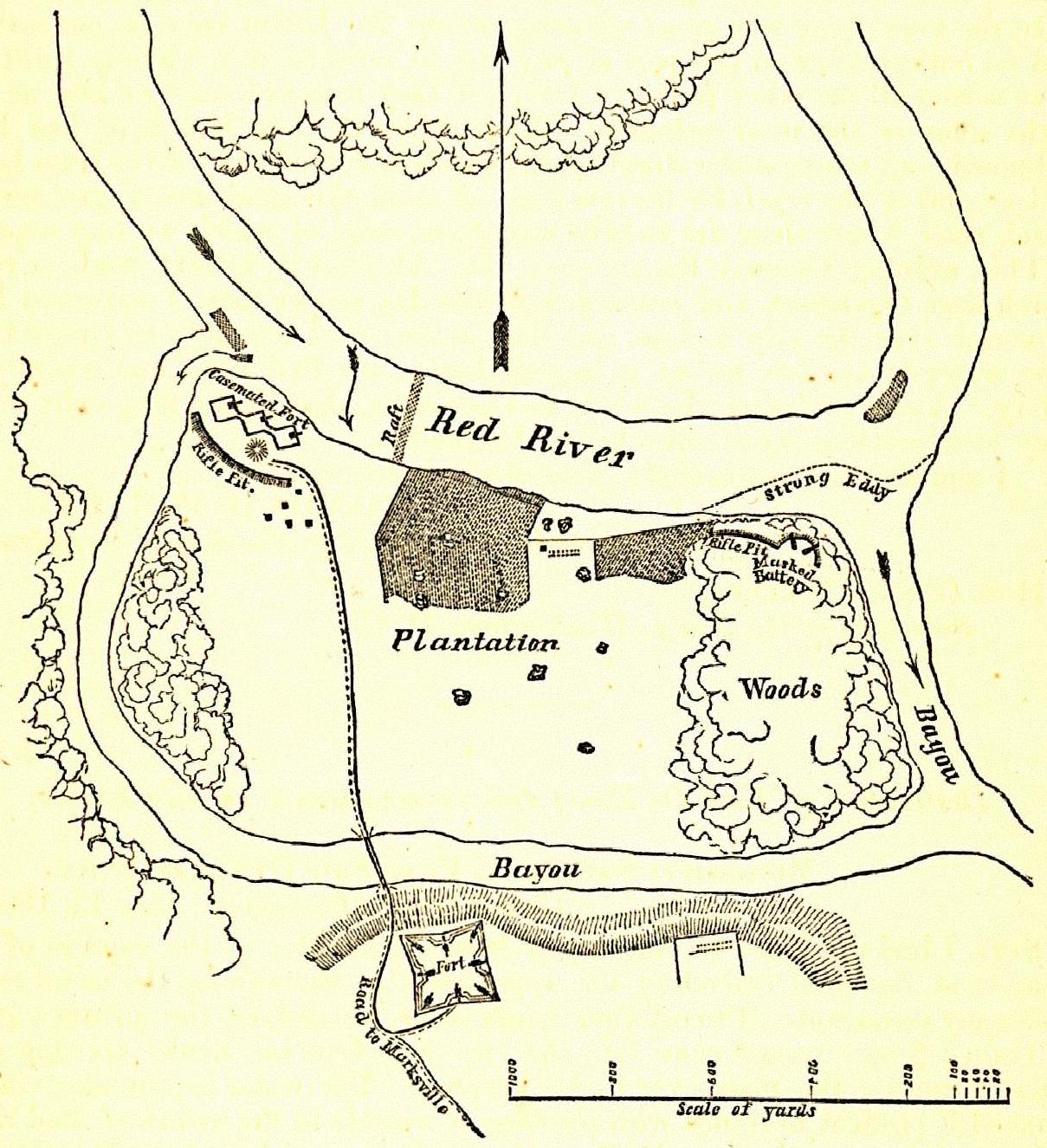|
USS Lafayette (1848)
The first USS ''Lafayette'' was a side wheel steamer, converted to an ironclad ram, in the United States Navy during the American Civil War. ''Lafayette'' was built at St. Louis, Missouri, in 1848 as ''Aleck Scott'' (often spelled ''Alick Scott''). She was purchased by the War Department as ''Fort Henry'' on 18 May 1862 for use in the western flotilla. She was converted to an ironclad ram at St. Louis by Edward Hartt. Renamed ''Lafayette'' on 8 September 1862, she was transferred to the Navy with the entire western flotilla by executive order on 1 October 1862. She was commissioned at Cairo, Illinois, 27 February 1863, with Captain Henry A. Walke in command. Service history Battle of Vicksburg, April–July 1863 The new ram joined Rear Admiral David Dixon Porter's Mississippi Squadron above Vicksburg in time for the famous dash on 16 April 1863 past the deadly batteries which protected the vital Confederate fortress. The gunboats engaged the southern guns as they shepher ... [...More Info...] [...Related Items...] OR: [Wikipedia] [Google] [Baidu] |
Vicksburg, Mississippi
Vicksburg is a historic city in Warren County, Mississippi, United States. It is the county seat, and the population at the 2010 census was 23,856. Located on a high bluff on the east bank of the Mississippi River across from Louisiana, Vicksburg was built by French colonists in 1719, and the outpost withstood an attack from the native Natchez people. It was incorporated as Vicksburg in 1825 after Methodist missionary Newitt Vick. During the American Civil War, it was a key Confederate river-port, and its July 1863 surrender to Ulysses S. Grant, along with the concurrent Battle of Gettysburg, marked the turning-point of the war. The city is home to three large installations of the United States Army Corps of Engineers, which has often been involved in local flood control. Status Vicksburg is the only city in, and the county seat of, Warren County, Mississippi, United States. It is located northwest of New Orleans at the confluence of the Mississippi and Yazoo rivers, and ... [...More Info...] [...Related Items...] OR: [Wikipedia] [Google] [Baidu] |
Fort DeRussy (Louisiana)
Fort DeRussy, located south of Alexandria, Louisiana, and four miles (6 km) north of Marksville, was a Confederate earthwork stronghold during the American Civil War. It was built in 1862 to defend the lower Red River Valley in Louisiana. Located in Avoyelles Parish, the fort, cemetery and water batteries were designated as a state historic site in 1994.Fort DeRussy official website Friends of Fort DeRussy"Fort DeRussy State Historic Site" Civil War Trust The fort and the water battery were listed on the |
Gideon Welles
Gideon Welles (July 1, 1802 – February 11, 1878), nicknamed "Father Neptune", was the United States Secretary of the Navy from 1861 to 1869, a cabinet post he was awarded after supporting Abraham Lincoln in the 1860 election. Although opposed to the Union blockade of Southern ports, he duly carried out his part of the Anaconda Plan, largely sealing off the Confederate coastline and preventing the exchange of cotton for war supplies. This is viewed as a major cause of Union victory in the Civil War, and his achievement in expanding the Navy almost tenfold was widely praised. Welles was also instrumental in the Navy's creation of the Medal of Honor. Early political career Gideon Welles, the son of Samuel Welles and Ann Hale, was born on July 1, 1802, in Glastonbury, Connecticut. His father was a shipping merchant and fervent Jeffersonian; he was a member of the Convention, which formed the first state Connecticut Constitution in 1818 that abolished the colonial charter and offi ... [...More Info...] [...Related Items...] OR: [Wikipedia] [Google] [Baidu] |
United States Secretary Of The Navy
The secretary of the Navy (or SECNAV) is a statutory officer () and the head (chief executive officer) of the United States Department of the Navy, Department of the Navy, a military department (component organization) within the United States Department of Defense. By law, the secretary of the Navy must civilian control of the military, be a civilian at least five years removed from active military service. The secretary is appointed by the President of the United States, president and requires confirmation by the United States Senate, Senate. The secretary of the Navy was, from its creation in 1798, a member of the president's United States Cabinet, Cabinet until 1949, when the secretary of the Navy (and the secretaries of the United States Secretary of the Army, Army and United States Secretary of the Air Force, Air Force) were by amendments to the National Security Act of 1947 made subordinate to the United States Secretary of Defense, secretary of defense. On August 7, 202 ... [...More Info...] [...Related Items...] OR: [Wikipedia] [Google] [Baidu] |
Bruinsburg, Mississippi
Bruinsburg is a ghost town in Claiborne County, Mississippi, United States. It was located on the south bank of Bayou Pierre, east of the Mississippi River. The town's port, Bruinsburg Landing, was located directly on the Mississippi River, just south of the mouth of the Bayou Pierre. Once an important commercial and military location, nothing remains today of the town or its port. History Bruinsburg is named for Peter Bryan Bruin, who emigrated from Ireland to Virginia in 1756, and later fought as a lieutenant during the American Revolution. Following the war, Bruin's father received of land in Mississippi in a grant from Don Diego de Gardoqui, a Spanish minister who controlled the region. Peter Bruin's family, along with 12 other families, moved there in 1778. The land grant required the settlers to survey the land, clear trees, build cabins, and plant crops. The settlers were soon growing corn, cotton, tobacco, indigo, fruits and vegetables. After the southern United ... [...More Info...] [...Related Items...] OR: [Wikipedia] [Google] [Baidu] |
Ulysses S
Ulysses is one form of the Roman name for Odysseus, a hero in ancient Greek literature. Ulysses may also refer to: People * Ulysses (given name), including a list of people with this name Places in the United States * Ulysses, Kansas * Ulysses, Kentucky * Ulysses, Nebraska * Ulysses Township, Butler County, Nebraska * Ulysses, New York *Ulysses, Pennsylvania * Ulysses Township, Potter County, Pennsylvania Arts and entertainment Literature * "Ulysses" (poem), by Alfred Lord Tennyson * ''Ulysses'' (play), a 1705 play by Nicholas Rowe * ''Ulysses'', a 1902 play by Stephen Phillips * ''Ulysses'' (novel), by James Joyce * ''HMS Ulysses'' (novel), by Alistair Maclean * Ulysses (comics), two members of a fictional group in the Marvel Comics universe * Ulysses Klaue, a character in Marvel comic books * Ulysses: Jeanne d'Arc and the Alchemist Knight, a light novel Film and television * ''Ulysses'' (1954 film), starring Kirk Douglas based on the story of Homer's ''Odysse ... [...More Info...] [...Related Items...] OR: [Wikipedia] [Google] [Baidu] |
Big Black River (Mississippi)
Big Black River is a river in the U.S. state of Mississippi and a tributary of the Mississippi River. Its origin () is in Webster County near the town of Eupora in the north central part of the state. From there it flows in a generally southwest direction until it merges with the Mississippi River south of the city of Vicksburg. It is the major contributor to the Big Black River Basin. It forms part of the northern border of Choctaw County, passes through Montgomery County, and forms the eastern border of Holmes County and the northern border of Claiborne County. The Big Black River and most of its tributaries are silt-filled. The rivers carry large amounts of suspended sediment, resulting mostly from agricultural runoff. These tributaries are slow-flowing muddy streams. However, some are swift-flowing with sandy bottoms. The Battle of Big Black River Bridge, fought during the Battle of Vicksburg, was part of the Vicksburg Campaign in the American Civil War. Big Black Riv ... [...More Info...] [...Related Items...] OR: [Wikipedia] [Google] [Baidu] |
Mississippi River
The Mississippi River is the second-longest river and chief river of the second-largest drainage system in North America, second only to the Hudson Bay drainage system. From its traditional source of Lake Itasca in northern Minnesota, it flows generally south for to the Mississippi River Delta in the Gulf of Mexico. With its many tributaries, the Mississippi's watershed drains all or parts of 32 U.S. states and two Canadian provinces between the Rocky and Appalachian mountains. The main stem is entirely within the United States; the total drainage basin is , of which only about one percent is in Canada. The Mississippi ranks as the thirteenth-largest river by discharge in the world. The river either borders or passes through the states of Minnesota, Wisconsin, Iowa, Illinois, Missouri, Kentucky, Tennessee, Arkansas, Mississippi, and Louisiana. Native Americans have lived along the Mississippi River and its tributaries for thousands of years. Most were hunter-ga ... [...More Info...] [...Related Items...] OR: [Wikipedia] [Google] [Baidu] |
Battle Of Grand Gulf
The Battle of Grand Gulf was fought on April 29, 1863, during the American Civil War. As part of Major General Ulysses S. Grant's Vicksburg campaign, seven Union Navy ironclad warships commanded by Admiral David Dixon Porter bombarded Confederate fortifications at Grand Gulf, Mississippi. One of the Confederate fortifications, named Fort Wade, was silenced, but the other, named Fort Cobun, continued firing. Due to the strong Confederate resistance, Grant and Porter decided it was not feasible to make an amphibious landing at Grand Gulf, but later landed at Bruinsburg, Mississippi, instead. After the Confederates were defeated at the Battle of Port Gibson on May 1, Grand Gulf was rendered indefensible and the fortifications were abandoned. The defenders of Grand Gulf then fought at the Battle of Champion Hill on May 16 and the Battle of Big Black River Bridge on May 17, before the start of the Siege of Vicksburg, which ended with a Confederate surrender on July 4. Today, th ... [...More Info...] [...Related Items...] OR: [Wikipedia] [Google] [Baidu] |
Laurent Millaudon (1856)
''Laurent Millaudon'' was a wooden side-wheel river steamboat launched at Cincinnati, Ohio, in 1856 operating in the New Orleans, Louisiana, area, and captained by W. S. Whann. At the beginning of the American Civil War she was taken into service by the Confederate Navy as CSS ''General Sterling Price''. On 6 June 1862, she was sunk at the Battle of Memphis. She was raised and repaired by the Union army, and on 16 June 1862 was moved into Union service as USS ''General Price'' and served until the end of the war. (''Dictionary of American Naval Fighting Ships'', 1968, p. 525) CSS ''General Sterling Price'' CSS ''General Sterling Price'', often referred to as ''General Price'' or ''Price'', was built as ''Laurent Millaudon'', (or ''L. Millandon'' or ''Milledon'') at Cincinnati, Ohio, in 1856. She was acquired for Confederate service and fitted out at New Orleans, Louisiana, for the River Defense Fleet (See DANFS appendix II) and was renamed after the Confederate general Sterling ... [...More Info...] [...Related Items...] OR: [Wikipedia] [Google] [Baidu] |
Cartagena, Spain
Cartagena () is a Spanish city and a major naval station on the Mediterranean coast, south-eastern Iberia. As of January 2018, it has a population of 218,943 inhabitants, being the region's second-largest municipality and the country's sixth-largest non-provincial-capital city. The metropolitan area of Cartagena, known as '' Campo de Cartagena'', has a population of 409,586 inhabitants. Cartagena has been inhabited for over two millennia, being founded around 227 BC by the Carthaginian Hasdrubal the Fair as ''Qart Hadasht'' ( phn, 𐤒𐤓𐤕𐤟𐤇𐤃𐤔𐤕 QRT𐤟ḤDŠT; meaning "New Town"), the same name as the original city of Carthage. The city had its heyday during the Roman Empire, when it was known as ''Carthago Nova'' (the New Carthage) and ''Carthago Spartaria'', capital of the province of Carthaginensis. Much of the historical significance of Cartagena stemmed from its coveted defensive port, one of the most important in the western Mediterranean. Cartagena has ... [...More Info...] [...Related Items...] OR: [Wikipedia] [Google] [Baidu] |








